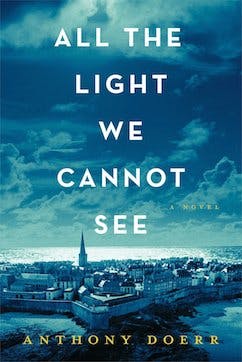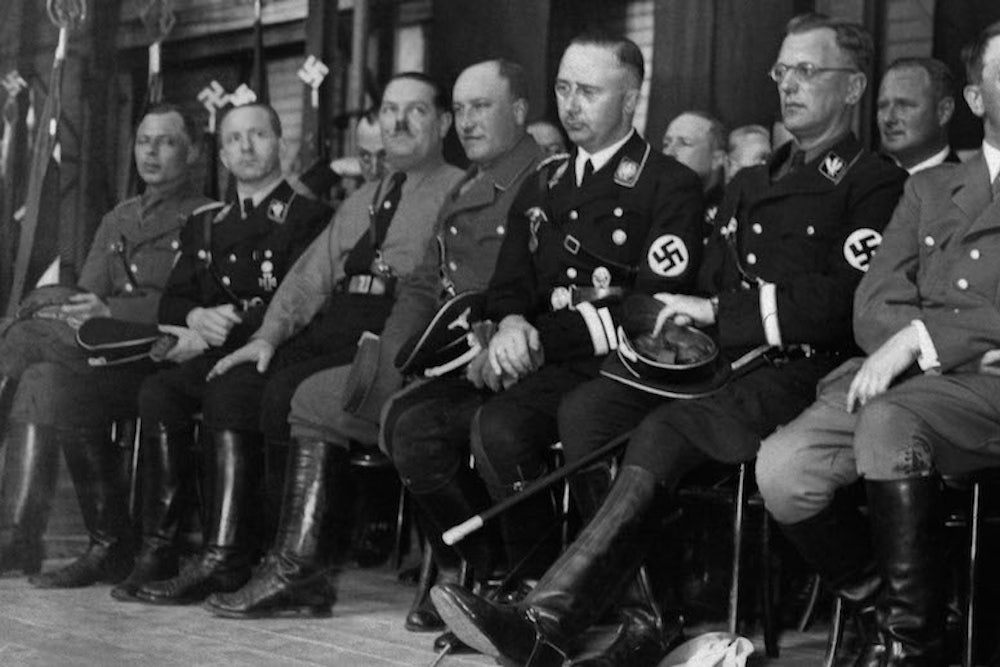“The more sentimental, the better,” reflects Werner, the albino Nazi child prodigy in Anthony Doerr’s surprise bestseller, All The Light We Cannot See. Here, as in the war, Werner picks the wrong side. Sentimentality is a potent and cheap smokescreen. It shelters us from the barrage of deeper emotions, and spares us from their ethical implications. It substitutes surfaces for depths, and glamor for complexity. A failure of taste is always an ethical failure, too.

Doerr’s novel, for those who have spent the last few months in a concrete bunker, is the impeccably implausible tale of two children caught in the violence of World War II. One of them is Werner, who, being an albino, is preternaturally gifted at assembling radios. His paramour, Marie-Laure, is a blind French girl, who, being blind and French, is prone to vague musings on the wonders of nature. The Nazis, who are handsome and dastardly when they are not crippled and humane, assign Werner to the task of hunting down the hidden radios of the Resistance. Members of the Resistance, who are more interested in French recipes than French resisting, hide a radio transmitter in the house to which Marie-Laure is evacuated, in the conveniently attractive seaside town of Saint-Malo. The plot grinds toward the meeting of Werner and Marie-Laure with the subtlety of a Tiger tank. The story ends with multiple detonations of high explosives and twee sentiment.
The blond leads the blind: Werner leads Marie through the rubble to safety, but dies by stepping on a landmine. After enduring so many of Werner’s trivial reflections, we are spared his final thoughts. They might resemble those of the reader, trying to identify fragments of actual history as they whizz past like so much fictional shrapnel. A novel is not a historical document, but it does become one, regardless of its author’s preference. Our entertainments reflect their times: how we choose to remember historical events, and how we prefer to remember them. Especially when the worst of times, World War II, becomes material for the lightest of entertainments.
Historians call this sort of thing “normalization,” or, if they are German, Vergangenheitsbewältigung, "coming to terms with the past." Through books and films, we process the exceptional and traumatic into the banal and mildly diverting. In a new book, Hi Hitler!: How the Nazi Past is Being Normalized in Contemporary Culture, the scholar Gavriel Rosenfeld describes a dispiriting catalog of normalizing strategies, political and commercial. Normalization is integral to memory and is always with us: the term "Holocaust" was popularized not by historians, but by a 1978 television series featuring James Woods and Meryl Streep. That said, the popularity of websites devoted to "cats that look like Hitler" suggests that what matters is less the normalization, and more how it is done.

Rosenfeld identifies three types of normalization: relativization, universalization, and aestheticization. The “relativizers” want to diminish the “moralistic aura” that comes with "exceptionality," the taint of particularly appalling actions. Recent practitioners include not just the obvious nationalist politicians, but also writers who, like Anthony Doerr, equate the Allied bombing of German targets with the earlier German bombing of everyone else. In Air War and Literature (1999), W.G. Sebald described the Allied raids with a Nazi term for the mass killing of Jews: a Vernichtungsaktion, an "act of extermination." Similarly, Jörg Friedrich's 2002 bestseller The Fire used Holocaust terminology to describe the suffering of German civilians: Air raid shelters became "crematoria."
The “universalizers” want to inflate the aura of exceptionality and liberate it as a license for present ambitions, especially humanitarian intervention. In her 1999 essay "To Suffer by Comparison," Samantha Power suggested that "Holocaustizing," the drawing of analogies to the Holocaust, had helped "stir the conscience" of American politicians during the Yugoslav Civil War and the Rwandan Genocide. But Power also saw that "Holocaustizing" could be counter-productive. Holocaust analogies did not force the Clinton administration to intervene in Rwanda, or after Srebrenica. The analogies could, however, attract a "backlash from those who believe in the uniqueness of the Holocaust," and could even encourage passivity: By comparison to the Holocaust, every humanitarian crisis might look "not so bad after all."
The third circle of normalizing Hell is reserved for the “aestheticizers.” The West, Rosenfeld writes, has a tradition that “historical events should be depicted from a realistic perspective.” Realism respects “a prevailing desire to preserve the integrity of the historical record.” This desire has “clear moral underpinnings,” even if, as with many of our moral underpinnings, we observe the principle in its breach. Many of those breaches are inspired by another tradition, more recent in origin, but now familiar to the point of tedium: the revolt against realism and its ethical implications. If the past can be shorn of its historical reality, it sheds its historic traditions, and the ethical demands they place on the present. Not all "relativizers" set out to neutralize the past. Many "relativizers" adopt new forms of representation in the hope of expressing "deeper moral agendas.” Sometimes they attain them. Chaplin and Mel Brooks prick the vanities of Nazism by ridicule. The fractured narrative of Elem Klimov’s 1985 film Come and See is a devastating recreation of the trauma of a child in the path of the Blitzkreig.
For Rosenfeld, all three forms of normalization distort the "historical record." Yet aestheticization is especially risky. It is less about the “moral dimensions of the past” than the “artistic challenges of representing it.” There is an inherent risk of “sacrificing substance for superficiality”—of falling for surfaces over depth, and for simplicity over complexity. Over time, this preference for form over content empties out the past. The willful amnesia of “normalization” smoothes out the abnormal discomforts of memory. Only the pretty, reflective surfaces remain. Beauty, Oscar Wilde wrote, “reveals everything, because it expresses nothing.”
Doerr's novel is an unsavory mixture of "relativizing" and "aestheticizing." As a relativizer, he presents all violence, Nazi or Allied, as equivalent: the product of amoral, deterministic forces. This mechanization might dumb the moral sense, but it raises the aesthetic value. As an aestheticizer, Doerr admires the shiny boots and tailored uniforms: Fascism, as Susan Sontag noted, always fascinates. There is, though, little depth to his reflections.
Ethical dilemmas, sadistic violence, technological cruelties, and sexy uniforms are all splendid sources of period style and emotional intensity. But, like rations of ersatz coffee and powdered egg, they are ready-made substitutes for the real thing. Realism brings us closer to the past, and to an understanding of its difference. The aesthetic perspective distances, and flattens difference. Instead of horror or heroism, we see only a lazy reflection of our own preferences and prejudices. Doerr’s German children speak like modern American children: they “do math on their fingers”, and call each other “gimp” or “pussy.” Doerr’s narrator speaks of “skunked” wine and “taffy-colored” hair. The difference between past and present has vanished.
Moreover, Doerr's writing is pompous, pretentious, and imprecise. Every noun is escorted by an adjective of reliable but uninspiring quality. Eyes are “wounded.” Brown hair is “mousy.” Absurdly, Wehrmacht recruits are “greyhounds, harvested from all over the nation for their speed and eagerness to obey.” I always thought greyhounds were bred, not picked like fruit. But then, I’m not a scientist. And neither is Doerr. He clutters his novel with technological whimsy about time, speed, and connectedness. Every event, especially a fatal one, is “destined” for reasons too mysterious and complex to explain. Science is an object of gawping wonder, but its merits remain beyond description, venerated but incommunicable.
“The incommunicable,” Sartre observed, “is the source of all violence.” There is a lot of violence in this novel. Most of it is sexualized and sadistic, slick with the voyeurism of horror films and pornography. Trapped in an attic for days, Marie-Laure is tormented by her imminent rape or murder at the hands of the man who has broken in downstairs; outside, the war machine approaches, “grinding and grinding its inhuman truth into the floor”.
The boys at Werner’s military academy chase their weakest members across the fields, then beat them with a thick rubber hose. The narration strokes the monstrous implement of punishment—“black, three feet long, stiff in the cold”—and savors the pain it causes. When the boys discover that dreamy Frederick has hidden his weak eyesight, they force-feed him eye charts, then beat him into a vegetative state. There are mock executions, and the ritual killing of a Slavic prisoner who is tied to a stake and freezes to death after repeated dousing in cold water.
Did I mention Doerr’s Sea of Flames? Apart from being a Wagnerian metaphor, the Sea of Flames is a diamond with magical powers. Marie-Laure’s father must hide it from the diabolical Nazi jeweler, Sergeant von Rumpel. We know he is diabolical because he walks with a limp, wheezes a lot, and has uncharitable thoughts about Jews.
Sergeant Rumpel is not the only villain to telegraph his wickedness by his ugliness. There is the one-armed sadist who leads exercises at Werner’s military academy, the cock-eyed soldier who is only following orders, and the French collaborator with bad breath and a weight problem. Eye trouble, on the other hand, indicates virtue in Doerr’s aesthetic, but also the kind of torments that stigmata portend for a medieval saint. Apart from blind Marie-Laure, the only other child with a conscience is Frederick. He gets pulped by his fellow cadets for hiding his myopia, and Marie gets bombed by the Americans.
When World War II is reduced to a conflict between technological determinism and innocent children, the difference between aggressors and defenders is erased. We see no evil, only “normalized” reflections in the Sea of Flames. Sometimes, the aesthetic is merely an anaesthetic.
